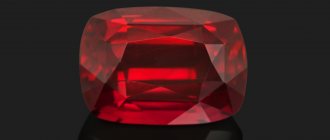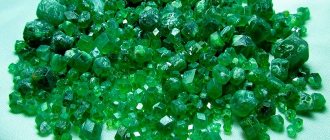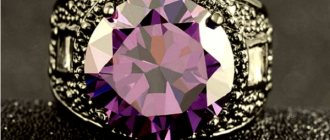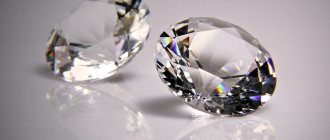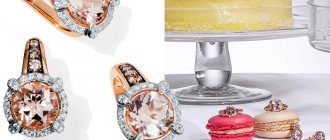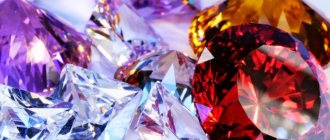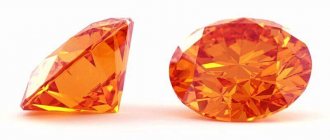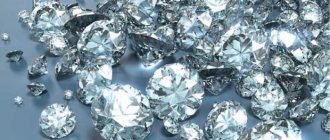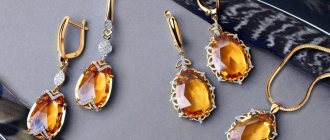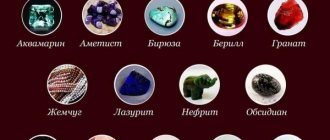History of the fishery
Legends about prospectors who mined treasures in the Ural Mountains go back centuries. In every village there is a tale about local residents who went to the mountains for gems and did not return.
The official history goes back three and a half centuries:
- The Tumashev brothers were the first to find colored pebbles in 1688, while exploring the Neiva River in the vicinity of Murzinskaya Sloboda. A colored stone boom began, and dozens of local peasants became miners.
- The first evidence of gem deposits along the banks of the Adui River dates back to the end of the 18th century.
The heyday of the fishery occurred during the reign of Catherine II (1762-1796).
The Empress patronized prospectors and kept the Yekaterinburg lapidary factory busy.
The 19th century was rich in discoveries:
- Magnificent beryls and amethysts are found. The discovery of the rarest red tourmalines was significant. They were caught by residents of the village of Shaitanka, the Kuznetsov brothers.
- Five years later, in 1815, the Mora mines were founded on the banks of the river. Connoisseurs all over the world still seek to buy local tourmalines today.
- By the end of the century, diamonds, sapphires, rubies, and malachite were discovered.
In 1900, local peasant Pyotr Rusin, while plowing a field, dug up miracle stones. So the village of Lipovskoye became a place of tourmaline mining. The guru of Soviet mineralogy, Academician Fersman, believed that in terms of beauty and depth of tone they were unrivaled.
Green tourmaline
The riches of the Urals are not exhausted; even tourists can, if they wish and have a bit of luck, find a pebble during an excursion.
Mineralogical and local history museums have been created in many cities of the Urals. The Rezhevsky State Natural and Mineralogical Reserve " Semi-precious Strip of the Urals " operates.
Academician Fersman argued that the Urals have no equal in the world in terms of the quantity and variety of minerals. But why exactly the Urals became the “box” of Russia, scientists are still figuring out.
Huge riches of the Urals
The region was “ignored” for a long time by the majority of scientists, and therefore industrialists. Although at the beginning of the 18th century, a local peasant brought almost half a kilogram of beryl to Yekaterinburg as an example. Even by the beginning of the 20th century, the mines were poorly described and were rarely visited by mineralogists.
However, the resources of the Urals have been used for more than two hundred years. For example, from just one mine on Adua (Murzinka) at the beginning of the 20th century, it was sometimes possible to produce more than 450 kg of cut aquamarine per year. The mines of the Southern Urals brought a lot of topaz.
Some stones have no equal in quality in the world, for example, cherry tourmaline. Back in the 18th century, the French called it siberite.
Precious
Almost all the minerals that jewelers and industrialists are interested in are found in the Urals.
Alexandrite
Some of the stones are especially prized, such as alexandrite, named after the Russian Tsar. The mineral was found in 1834. The largest deposit, Malyshevo, is located in the Urals.
The description of the stone is similar to an emerald, so at first they were confused. A little later, an optical effect was noticed, which was called alexandrite. The mineral turned out to be able to change color. Ural alexandrites have bright, rich shades of blue, green, red, and violet. These are expensive high quality stones.
Emerald
Emerald is another calling card of the Urals. The development of the deposits began in the 19th century, but the mines still hide a lot of wealth. So, five years ago, a kilogram emerald was discovered at the Malyshevsky deposit.
These Ural minerals have an intense green color due to the iron and chromium in their composition. Emerald is a fragile stone, so crystals without small defects are rarely found. If they are not there, this should alert you. This gemstone is often counterfeited. In natural emeralds, the cracks are filled with resin and treated with cedar oil using a special technology.
Topaz
Topaz is another pride of the Urals. The Ilmenskoe deposit is especially famous. During excavations near the Ugalinsky lakes, archaeologists were convinced that topazes were also valued by primitive people - products made from this stone were found.
They began mining the gem after the Cossack Prutov discovered the mineral in 1772. Most of the stones were found near the Sanarka and Kamenka rivers. Today, topaz deposits in the Urals are almost depleted.
Local minerals have different shades: from pink, yellow to intense wine, purple. In each mining area, topazes have their own shape and predominant color, for example:
- in Murzinka, Aduysky mines - yellow, blue;
- in the Southern Urals - pink, crimson.
Amethyst
According to experts, Ural amethysts are the best in the world. Stones found in other parts of the planet, as a rule, lose their saturation and play of color under artificial lighting. This cannot be said about natural Ural amethysts: they retain their shine. The gems that were found near Sanarka, Murzinki, are red.
Most Ural amethysts are purple. Abroad they are often called Siberian.
Demantoid
Demantoid is a green or yellowish stone related to garnets (andradite). Some minerals cost more than ten thousand dollars per carat. The best representatives are some of the most expensive gems.
The play of light on a crystal is no worse than on a diamond. Demantoids found in the Urals often have a ponytail. This is the name for byssolite impurities in the form of golden tufts. Such stones are valued higher.
A lot of demantoid is mined only in the Middle Urals. Samples from the Sysert region are popular and recognized. The world's largest deposit is Karkodinskoye.
Diamond
Diamond is known as one of the strongest stones. Often it is white, gray, black, less often - yellowish, brownish. Sometimes greenish, bluish, pinkish, colorless. Russia is in first place in terms of diamond reserves and production. Most stones are mined in Yakutia.
Until 1956, diamonds were mined only in the Urals: in the Perm (Molotov) region. The first crystal was found in 1829 near the Poludenka River. Today, the Perm Territory's share is only 0.1% of Russian production. Although the cost is already 2%. Ural diamonds are among the most expensive in the world. In addition, in Yakutia, getting them is from 3 to 12 times more expensive. For this reason, diamond mining in the Urals is unlikely to stop. Perhaps they will look for new deposits.
Mariinsky
Even today, discoveries are being made in the mountainous region. For example, in 2011, scientists from the Academy of Sciences discovered a new stone in the Urals. It is similar in composition to alexandrite. The name of the mineral is Mariinskite. It is green and does not change color in the light.
Ornamental
The following ornamental gems are distinguished.
Malachite
The collection “Malachite Box” by Bazhov has been translated into dozens of languages, and is recommended for schoolchildren by the Ministry of Education. The name was not chosen by chance. Malachite is truly one of the most recognizable ornamental stones of the Urals. This is a green mineral with a pattern. The shades and intensity of the shine differ.
Orlets
In the Urals there is a lot of orlets, or rhodonite of the highest quality. It has a cherry color. There are different shades that are combined with a pattern of veins and spots. Rhodonite was discovered in the Urals. The most famous deposit is located near the village of Maloe Sedelnikovo. Orlets is classified as a semi-precious ornamental mineral.
Jasper
Jasper is especially common in the Southern Urals. Here, entire rocks are made of it. The color of this variegated stone can be any, for example, Kalkan jasper is gray-green, Muldakaevskaya is gray-blue. In addition to the main tone, there are multi-colored spots and stripes in a unique combination. According to connoisseurs, local specimens are distinguished by their rare beauty. The minerals mined near the city of Orsk are distinguished.
Rose quartz
Rose quartz is also found in the Urals. Most crystals are cloudy and have cracks. The stone is used as an ornamental stone. Transparent rose quartz is sometimes found. This rare mineral is prized by jewelers.
What kind of gems is the Urals rich in?
In the Urals, gems of all orders are found, from precious to ornamental:
- Diamond, ruby, sapphire, emerald, alexandrite.
- Demantoid, rose quartz, aquamarine, amethyst, tourmaline, topaz, rauchtopaz, rock crystal.
- Malachite, rhodonite, jasper, serpentine.
Green malachite
Some gems are found for the first time or are mined only here, which affects the cost.
The minerals of the Urals are unique:
- Local emeralds are easily identified by their rich green color and clarity. Demantoids, called Ural emeralds, are similar to them.
Emeralds - The gem discovered by local scientists in 2011 is Mariinskite. According to the description, it is similar to alexandrite; the absence of pleochroism allows it to be distinguished. Named after the place of discovery - the Mariinsky mine. Its main characteristics: hardness, formula, composition are known. Esotericists study healing and magical properties.
- Shaitan's overflowing also looks like alexandrite. It was found by chance, on an emerald vein near the village of Shaitansky. It turned out that this is a layered variety of quartz of greenish-blue shades.
Shaitan overflow is mined only in the Urals, which increases its price on the world market for collectible stones.
Of particular importance is malachite, the main brand of the Urals. No wonder Pavel Petrovich Bazhov called the collection of his tales about the Urals “Malachite Box”.
Malachite box
Amethyst
Amethyst
In its chemical essence it is quartz with various impurities. Its color is all shades of purple, sometimes with red reflections. Usually the color of quartz is not attractive; it is cloudy, with a gray tint. However, amethyst was lucky. Iron and manganese, which are part of the crystal lattice, give the stone its color under the influence of temperature and the electromagnetic field of the Earth. But under the sun's rays, the amethyst formed in geodes fades. A stone extracted from rock crystal does not have this feature. Not only processed stones are attractive, but also amethyst druses. They rarely reach large sizes. Often these are many small crystals fused together. The Southern Urals are not the only place where amethysts are mined. Large deposits are also found in Sri Lanka, Africa and Mexico.
Place of Birth
The deposits are located throughout the mountain ranges - almost 100 km from north to south.
The most famous places for mining gems: Murzinka, Malyshevskoye, Shaitanka, Gumeshevsky.
Among the finds are a jewelry beryl crystal (25 cm; 1828, Murzinka) and a President emerald (crystal intergrowth of 1.2 kg; 1993, Malyshevsky mine).
Emerald President Malyshevsky mine
The term “Gem Strip of Russia” was coined at the beginning of the 20th century by the founder of the Department of Mineralogy of the Ural Mining Institute, Konstantin Matveev.
The USSR Post issued a series of stamps “Ural Gems” in 1963.
Malachite
Malachite
Malachite, bright green in color with intricate patterns, brought glory to the Urals. But these are not the largest veins of this mineral. For example, Congo produces much more of it. All over the world it is primarily copper ore, but in our country it is an ornamental material.
Chemically, it is copper bicarbonate. It was formed from the interaction of copper ores and groundwater. These solutions, crystallizing, fill the voids in the crust. The name of the mineral was given by the ancient Greeks. The stone began to be used to make jewelry more than 10 thousand years ago. It is believed that the first eye shadow was made from malachite powder and was introduced into fashion by the Egyptians.
In Russia, in addition to figurines, vases, candlesticks and other crafts, green paint was made from ore fragments. Before the Revolution in Yekaterinburg and Nizhny Tagil, roofs were covered with it. Ural craftsmen learned to make mosaics from high-grade ore. Thin plates were sawn into squares, which were selected according to the design into one picture, and then polished and ground so that the joints were invisible. The large items presented in the Hermitage, which are of high value, are not a monolith, but individual pieces.
Where are gems used?
Use was found for all the gems. Some are used in jewelry, others are suitable for large items.
The property of the Hermitage is the Malachite Hall and a cameo carved on the overflow personally by Catherine II.
Malachite Hall
The columns of St. Isaac's Cathedral in St. Petersburg are lined with malachite.
Mantelpieces, tabletops, vases, and jewelry made from Ural stones are considered status items.
Gems from the Urals have different properties, characteristics, and values. But you need to take care of each product carefully.
Topaz
Topaz
Topaz belongs to the jewelry stones. In the Urals, in the vicinity of Murzinka, a record topaz “Pobeda” was found, which is now stored in the State Storage. The weight of the stone is 43.6 kg and it consists of individual crystals. The miner who found him personally transported him by train to Sverdlovsk, and from there under guard to Moscow. Nowadays you won’t surprise many people with topaz. The stone of natural origin is dim and tends to fade in sunlight. In this regard, before becoming part of jewelry, stones undergo preparation. They are irradiated with X-rays or heated. Sometimes both methods of refining are used. From this, topaz acquires a rich blue or light blue color.
Precious stones of the Urals - the pride of the country
Natural stones of the Urals were discovered not by large industry or even jewelry firms, but by small self-taught artisans who learned to extract gems and process them starting in the 18th century.
Until the second half of the 20th century, in remote Ural villages, in the middle of the swampy taiga, one could meet these desperate artisans who descended into primitively constructed mines, devoid of technical equipment.
Here, in the famous Murzinka, dark amethyst was mined, which took on a bloody hue in artificial light, and bluish and colorless topazes, called heavyweights.
One of the most beloved and characteristic gems of the Urals is malachite, which began to be mined in large quantities after the opening of copper mines. In those days, thousands of pounds of dark and light green emerald were extracted from the mines of Gumeshevsk and Mednorudyansk. Poor grades and fragments of mineral were abraded into paint.
And from higher grades, craftsmen learned to make stunning products using a method that later became known as “Russian mosaic.” To do this, fragments of malachite were sawn into plates several millimeters thick. Later from plates on metal or marble according to the pattern of the stone.
At the same time, the seams were adjusted so carefully that the impression of solidity was created. The method was invented in the second half of the 18th century. Russian craftsmen, like plywood, lined huge bowls, tables, vases and columns with Ural malachite.
The second stone that the Ural region is proud of is the eagle, which is not found anywhere else in such huge quantities and of such the highest quality as in Russia. Orlets, also known as rhodonite, has a cherry-pink color, the main advantage of which is the combination of various shades of this color with dark spots and winding veins. Mainly, the eagle was used to make bowls, vases, and candelabra.
The third stone representing the group “precious stones of the Urals” is jasper. No other type of jasper in the world can compete with the Ural gem. This is a dense rock, highly polished, widespread in the Southern Urals, where large rocks are formed from it.
Here you can find gray-green jaspers (Kalkan variety), grayish-blue (Muldakaevskaya), as well as red and yellow jaspers. No less popular are gems consisting of alternating stripes of green, yellow, red and other colors.
The most amazingly beautiful variegated jaspers are found near the city of Orsk. This variety is distinguished by its variety of colors and variegation. Products made from Ural jasper have been the subject of universal admiration for a long time. Look at the stones of the Urals in the photo, they are all worthy of attention.
